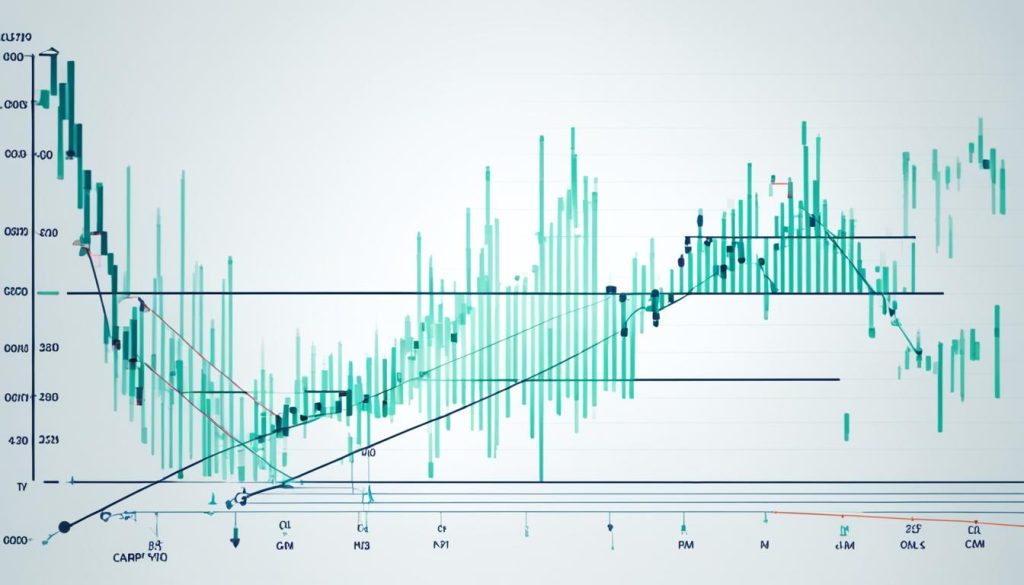The capital asset pricing model (CAPM) is a key finance theory. It links systematic risk with expected return for assets like stocks1. In the 1960s, William Sharpe, John Lintner, and Jan Mossin created it. Now, it’s a key tool for setting prices on risky securities and planning investments1.
By grasping the CAPM, you can make smarter choices. This helps shape your investment strategy for better portfolio performance.
Key Takeaways
- The CAPM formula links the needed return on an investment with its risk in a straight line.
- CAPM uses expected returns on the market and a risk-free asset, plus the asset’s market sensitivity (beta), to figure out an investment’s expected return.
- CAPM is key for valuing assets, optimizing portfolios, figuring out equity capital costs, and checking investment performance.
- The market risk premium is what investors want extra for market investing over the risk-free rate. This is for handling market risk.
- Even with its limits, CAPM is a big deal in finance and a great tool for investors.
Understanding the Capital Asset Pricing Model (CAPM)
The Capital Asset Pricing Model (CAPM) helps us understand investment risks and expected returns. It was created in the 1960s by economist William Sharpe. CAPM says there are two kinds of risk: systematic and unsystematic risk2.
Systematic risk, or market risk, affects all assets and can’t be avoided. On the other hand, unsystematic risk, or specific risk, can be lowered by spreading out investments2.
Key Terms for the Capital Asset Pricing Model
Important terms in CAPM include the risk-free rate, beta, and market risk premium3. Beta shows how an asset moves with the market. A beta over 1 means it’s more volatile, and a beta under 1 means it’s less volatile3.
The market risk premium is the extra return people want for taking on market risk instead of safe investments3.
What Is the CAPM Formula?
The CAPM formula helps figure out an asset’s expected return based on its risk:432
ER = Rf + β(ER_m – Rf)
Where:
- ER is the expected return
- Rf is the risk-free rate
- β is the asset’s beta
- ER_m is the expected market return
This formula helps check if an asset is priced right by looking at its future cash flows and expected return. If the present value matches the current price, the asset is seen as fairly priced for its risk4.
“CAPM is key for figuring out the weighted average cost of capital (WACC). This is crucial in financial modeling to find the net present value (NPV) of investments.”3
The Capital Asset Pricing Model in Practice
Let’s look at how the Capital Asset Pricing Model (CAPM) works in real life. Imagine the risk-free rate (Rf) is 1.05%, the expected market return (ER_m) is 11%, and a stock has a beta (β) of 1.55. Using the CAPM formula, we get the expected return (ER) for this stock: ER = 1.05% + 1.5 × (11% – 1.05%) = 16%5. This expected return helps us figure out the stock’s value and if it’s priced right based on its risk.
The CAPM is key in finance for figuring out the value of assets and helping with investment choices. For instance, using the CAPM formula, we found the expected return was 16%. This was based on a one-year treasury yield of 1.05%, the S&P 500 return of 11%, and a stock’s beta of 1.55.
| CAPM Component | Value |
|---|---|
| Risk-free rate (Rf) | 1.05% |
| Market return (ER_m) | 11% |
| Beta (β) | 1.5 |
| Expected return (ER) | 16% |
The CAPM formula is: ER = Rf + β × (ER_m – Rf). ER is the expected return, Rf is the risk-free rate, β is the stock’s beta, and ER_m is the expected market return5. This shows how the CAPM helps estimate the expected return for an asset. This info is useful for making investment choices and managing portfolios.
Why the Capital Asset Pricing Model Matters
The Capital Asset Pricing Model (CAPM) is key in financial modeling and valuing assets6. Analysts use it to find the stock’s fair value by calculating the expected return from the CAPM. This expected return is part of the weighted average cost of capital (WACC)6. Then, they discount the company’s future cash flows to get the stock’s fair value6. Decisions on investments are made by comparing the current price to this fair value6.
Knowing the CAPM helps investors make smarter choices about their investments’ risk and return6. It shows that every investment has two risks: systematic risk (beta) and company-specific risk6. The Sharpe ratio, created by William F. Sharpe, measures how much risk a fund takes on versus its return6.
The CAPM has grown over time, tackling more complex issues beyond just risk and return6. Markowitz’s Portfolio Theory focused on finding the best mix of risk and return for investments6. Sharpe’s work led to a simpler way to analyze portfolios in 19636.
The Capital Asset Pricing Model (CAPM) connects higher expected returns with more risk, as measured by beta6. Beta shows how an asset might do badly in tough times. Assets with high betas tend to perform worse in downturns6.
| Metric | Value |
|---|---|
| Average rate of return for the three-month US Treasury security (1928-2020) | 3.36%7 |
| Standard deviation of returns for the US Treasury bills | 3.0%7 |
| Lowest annual return for US Treasury bills | 0.03% (2014)7 |
| Average return for the S&P 500 stock index (1928-2020) | 11.64%7 |
| Standard deviation of stock returns | 19.49%7 |
| Number of years with negative S&P 500 returns (1928-2020) | 257 |
| Risk premium for stocks over US Treasury bills | 8.28%7 |
| Beta for DAL stock | 1.397 |
| Expected return of DAL using CAPM | 14.87%7 |
The CAPM’s role in investment decisions is huge. By understanding and using this model, investors can make smarter choices about their investments’ risk and return. This leads to better management of their portfolios and asset allocation strategies.

Advantages and Disadvantages of the CAPM
The Capital Asset Pricing Model (CAPM) has both good and bad points for investment strategies. It offers a clear way to link risk and return8. It’s a key tool in finance, helping to figure out expected returns9. But, it also has its downsides that investors should think about.
Criticisms of the CAPM
One big issue with CAPM is figuring out its key variables. The risk-free rate, beta, and market risk premium can be hard to pin down and change often8. Also, CAPM assumes a simple link between risk and return, which might not be true in real life9.
Some say beta doesn’t cover all the risks investors face9. This means CAPM might not always get expected returns right, especially in the short term8. It also assumes markets work perfectly, which isn’t always the case.
Also, CAPM thinks investors can borrow and lend at the same rate as the government, which isn’t true for most people8. This can mess up how you calculate the return needed.

Even with its flaws, the CAPM is still a big deal in finance. It helps investors start to look at investment chances. Knowing its good and bad points is key for making smart choices and planning investment strategies89.
Capital Asset Pricing Model: Its Role in Portfolio Management
The10 Capital Asset Pricing Model (CAPM) is key to modern portfolio theory (MPT). It helps investors build portfolios that give the best return for a certain risk level. The CAPM shows the efficient frontier, which are the best portfolios for a given risk level10.
Understanding how risk and return are linked by the CAPM helps investors make better choices about portfolio diversification and where to put their money. The CAPM formula shows how a portfolio’s expected return depends on the risk-free rate, the market’s return, and its risk10.
Investors can check their portfolio’s performance using indices like the Sharpe Performance Index, Treynor Performance Index, and Jensen Performance Index10. These indices help see if a portfolio is doing well and if it matches the investor’s goals10.
Metrics like tracking error and information ratio show how a portfolio does against its benchmark. The Sortino Ratio looks at the risk of losing money10. Using these CAPM metrics, investors can make better choices to improve their portfolio and reach their financial goals10.

The CAPM is vital for11 portfolio management. It helps investors understand the link between risk and return. It also guides them in making efficient and diverse portfolios10.
Conclusion
The capital asset pricing model (CAPM) is key to your investment strategy. It shows how risk and expected return are linked12. By using the risk-free rate, beta, and market risk premium, you can figure out an asset’s expected return. This helps you see if it’s priced right12.
Understanding the CAPM helps with making better investment choices. It’s used a lot in finance to help investors make smarter decisions12. The model shows the link between risk and reward. But, it relies on past data and might not always predict the future12.
Even with its limits, the CAPM is still a key tool in finance. It gives you a solid base for understanding what drives asset prices and returns. This helps you plan a strategic and informed investment approach.
As you work on improving your investment strategy, knowing the CAPM’s role is key13. It helps you evaluate if an investment is a good choice13. By using the CAPM, you can make better decisions about what you want from your investments. This can help you build a portfolio that does well over time.
FAQ
What is the capital asset pricing model (CAPM)?
The capital asset pricing model (CAPM) links systematic risk to expected returns for assets like stocks. It’s a finance model that shows a direct link between an investment’s required return and its risk level.
What are the key terms in the CAPM?
Important terms in the CAPM include expected return, risk-free rate, beta, and market risk premium. Beta shows how an asset’s volatility compares to the market. A beta above 1 means higher volatility. The market risk premium is the extra return investors want for taking on market risk over risk-free assets.
How is the CAPM formula calculated?
The CAPM formula uses risk to find an asset’s expected return: ER = Rf + β(ER_m – Rf). ER is the expected return, Rf is the risk-free rate, β is the asset’s beta, and ER_m is the expected market return.
How can the CAPM be used in practice?
The CAPM helps check if an asset is priced right by discounting its future cash flows with the expected return. If the present value matches the current price, the asset is seen as fairly priced for its risk.
What are the advantages and disadvantages of the CAPM?
The CAPM offers a clear way to link risk to return, making it a key tool in finance. Yet, it has limits, like unclear input variables and a simple risk-return relationship assumption.
How is the CAPM related to modern portfolio theory (MPT)?
The CAPM is tied to modern portfolio theory (MPT), which says investors can make the best portfolios for a set risk level. The CAPM helps find the efficient frontier, which shows the best portfolios for a given risk level.

